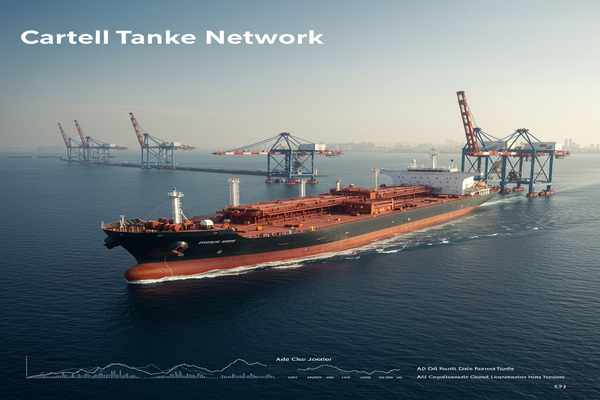
Mexico’s dark tanker fleet is enabling cartels to smuggle large volumes of diesel, and that is changing short term price signals and trade flows. The seizure of a nearly 120,000 barrel load in Ensenada highlights how covert ship movements, rapid truck transfers and organized networks can flood local markets with cut rate fuel. In the short term this adds downward pressure on Mexican diesel prices and raises volatility in border fuel trade. Over the long term it can erode state fuel revenue, increase compliance and insurance costs for shipping and create persistent cross border arbitrage that matters to North American and broader emerging market energy trade.
Immediate market implications
Why the Ensenada episode matters for the next trading session.
The Torm Agnes call at Ensenada and the rapid transfer of product to truck fleets shows how quickly illicit fuel can reenter commerce. That speed matters for traders because it can alter short term demand indicators and distort visible flows that traders use to set prices. Market participants who watch weekly fuel movement data will see spikes that do not reflect legal commercial demand. That can prompt re pricing in diesel futures and narrow regional cash differentials for a few days.
Local dealers and border wholesalers face immediate margin pressure when cut rate product competes with legitimate supply. That pressure can reduce demand for imports into northwest Mexico and reduce cross border truck flows into adjacent U.S. states. The result is localized volatility that can ripple into broader Gulf coast trading hubs as traders reassess arbitrage opportunities for physical cargoes.
Oil and diesel market dynamics
How bootlegged diesel changes flows, refining margins and freight demand.
Illicit volumes that enter coastal markets bypass normal trading channels. That weakens nearby spot prices for diesel and raises uncertainty around actual refinery offtake. When visible demand dips but total consumption remains steady because of bootleg supplies, refining margins in the region can come under pressure. That reduces the incentive for refiners to run at higher rates and can leave spare crude that traders reallocate to other markets.
For oil futures the immediate move is usually muted because global benchmarks reflect broad supply and demand. However, regional crude and product spreads can widen. Freight demand for product tankers can change quickly if a portion of volumes shifts from open-market shipments to clandestine operations. That change can tighten capacity on legitimate routes and push short term freight premiums higher for compliant shippers.
Regional markets, fiscal effects and the peso
Local political economy can affect the peso, public finances and investor sentiment.
Cut rate fuel sold outside official channels reduces tax receipts and lowers receipts for state fuel operations. That weakens public finance metrics in areas that depend on fuel taxation. Investors who track fiscal data and government cash flow may see an increased risk premium on assets exposed to those revenue streams. For the Mexican peso the transmission is indirect but tangible. Lower tax intake and a hit to local energy firms can ease inflows that normally support the currency and increase volatility in currency trading against the dollar.
Traders in equities and bond markets will watch for statements from authorities that signal enforcement steps. A stepped up crackdown can support local sentiment by restoring legal flows. Conversely, prolonged impunity for smuggling can weigh on investor confidence and limit the appeal of domestic credit and equity markets in the region for a period.
Shipping, insurance and compliance risks
Dark fleet tactics raise operational costs for carriers and insurers and complicate compliance.
The use of vessels operating outside standard tracking and reporting systems forces carriers and insurers to reassess risk models. Underwriters may demand higher premiums for product tonnage in regions where dark fleet activity has a strong foothold. That can increase the cost of legally moving product and reduce available tonnage for regular commerce. Ports that become known as entry points for illicit cargoes can face tighter inspections and longer turnaround times, which raises operational costs for legitimate imports and exports.
Regulators in multiple jurisdictions may respond with enhanced tracking, tougher flag state scrutiny and more aggressive port state control. Those measures can correct market distortions over time but they also create short term compliance costs that traders must price into transactions.
Session watchlist and market signals to follow
Key indicators that traders and risk desks will track in the coming session.
Market participants will look for changes in reported diesel flows at Pacific coast terminals, any official statements from Mexican authorities on enforcement actions and anomalies in regional spot differentials that could point to hidden volumes. Freight rate moves on product tanker routes that serve northwest Mexico will signal whether capacity is tightening for legitimate cargoes. Traders will also monitor currency moves in the peso for signs that market participants are re pricing sovereign or fiscal risk tied to fuel tax receipts.
Global oil benchmarks will remain influenced by broader supply and demand information but regional price action in diesel and product crack spreads will provide more immediate cues about the economic impact of the dark fleet. For the upcoming trading session, the mix of official data releases, port reports and shipping notices should determine intraday volatility more than a single directional trend.
The Ensenada incident underscores that hidden channels can quickly alter visible market signals. For traders and risk managers, the priority will be to separate noise created by illicit flows from true commercial demand. That distinction will determine how markets re price risk in the short term and how longer term structural responses from regulators and insurers reshape costs and flows in the months ahead.












